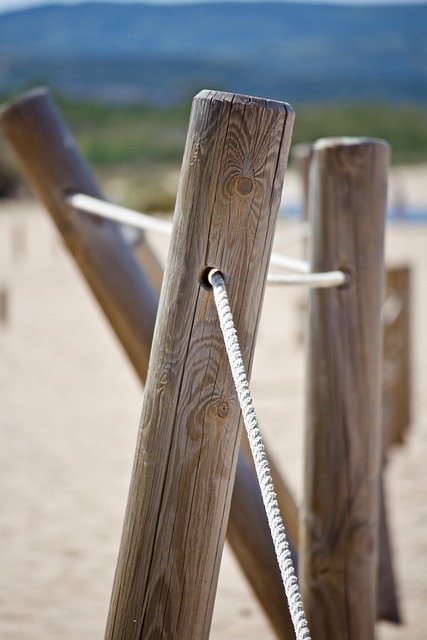Fences serve not only as structural elements but also as a design statement for your outdoor space. Fence staining and sealing are essential practices to protect wood, enhance aesthetics, and ensure longevity. This guide delves into the art of enhancing wooden fences, covering everything from understanding the benefits of staining, choosing the perfect color, application techniques, the role of sealing, and vital maintenance tips to keep your fence looking its best for years to come.
- Understanding Fence Staining: Benefits and Types
- Preparing Your Wooden Fence for Staining
- Choosing the Right Stain: Color Options Explored
- Application Techniques for Even Coverage
- Sealing Your Fence: Protection Beyond Staining
- Maintenance Tips for Longevity and Beauty
Understanding Fence Staining: Benefits and Types
Fence staining is an effective way to protect your wooden fences from the elements, enhance their aesthetic appeal, and increase their lifespan. Understanding the benefits and types of fence staining is crucial for making an informed decision. One of the primary advantages is its ability to shield wood from ultraviolet (UV) rays, rain, snow, and extreme temperatures, which can cause fading, cracking, and rot. This protective layer not only preserves the fence but also maintains its natural beauty.
There are various types of fence staining solutions available, each offering distinct features. Water-based stains are popular for their low odor and quick drying time. They provide a transparent finish that highlights the wood grain while adding a protective barrier. Oil-based stains, on the other hand, offer deeper color options and better penetration into the wood, creating a more durable seal. For a more decorative touch, semi-transparent or solid colors can be chosen to transform the fence into a focal point of your outdoor space.
Preparing Your Wooden Fence for Staining
Before applying any stain or sealer to your wooden fence, proper preparation is key. Start by thoroughly cleaning the fence using a pressure washer or a stiff-bristled brush and soapy water. This removes dirt, debris, and any existing finish, ensuring better adhesion for the new coating.
Next, sand the surface of the wood gently with fine-grit sandpaper to create a rough texture. This step helps the stain penetrate deeper into the wood fibers, enhancing the final color and durability. Remember to remove all dust after sanding using a damp cloth or vacuum to avoid any residue affecting the staining process.
Choosing the Right Stain: Color Options Explored
When choosing a fence stain, color is a significant factor to consider. The right shade can transform your wooden fence, enhancing its natural beauty or creating a bold aesthetic statement. Stains come in various colors, from earthy tones like browns and greens to vibrant options like reds and blues. Dark stains offer better concealment of the wood’s natural color, while lighter shades highlight the wood grain, giving it a more natural look.
Color selection also depends on your personal preference and the fence’s surrounding environment. For instance, lighter colors reflect sunlight, making them suitable for fences in hot, sunny locations, while darker shades absorb heat, which can be beneficial in cooler climates. Additionally, consider the effect you want to achieve—a subtle, natural blend or a striking, contrasting color—to ensure your chosen stain complements both the fence and its surroundings.
Application Techniques for Even Coverage
For even coverage when staining and sealing your wooden fence, proper application techniques are key. Start by preparing the surface thoroughly – clean it to remove any dirt, mold, or previous coatings. This ensures that the new stain adheres well. Use a brush for corner and detail work, as it allows for precise control over these areas. For larger, flat surfaces, a roller is ideal as it applies an even coat quickly. Maintain a consistent pressure while rolling to avoid misshapen or overspotted spots.
When sealing, follow the product’s instructions regarding application method and drying time. Typically, a brush is sufficient for applying sealer, though a sprayer can be used for faster coverage. Maintain a distance of about 6-8 inches from the fence to prevent overspray. After applying, allow the first coat to dry completely before adding additional layers for maximum protection and longevity.
Sealing Your Fence: Protection Beyond Staining
After staining your wooden fence, the next step is to seal it for enhanced protection and longevity. Sealing acts as an extra layer of defense against the elements, including sunlight, rain, and extreme temperatures, which can all contribute to the deterioration of wood. Not only does sealing prevent fading and yellowing, but it also shields the fence from mold, mildew, and fungal growth, ensuring that your investment remains in pristine condition for years to come.
Choose a high-quality sealant designed specifically for wooden fences, and apply it evenly using a brush or roller. Regular reapplication every few years is key to maintaining the seal’s effectiveness. This simple step goes a long way in preserving the beauty of your fence, allowing you to enjoy its enhanced aesthetic appeal without constant maintenance concerns.
Maintenance Tips for Longevity and Beauty
Regular maintenance is key to preserving the beauty and longevity of your wooden fence. Start by cleaning the fence at least once a year to remove any dirt, mold, or mildew buildup. Use a soft-bristled brush and a mild detergent mixed with water; ensure you rinse thoroughly afterward.
After cleaning, apply a fresh coat of stain or sealant every 2–3 years, depending on your climate and exposure to the elements. This protective layer shields the wood from UV rays, rain, and other environmental factors that can cause fading and rot. Regular inspection for any signs of damage or moisture intrusion is also essential; repair or replace any damaged sections promptly to maintain structural integrity and prevent further deterioration.
